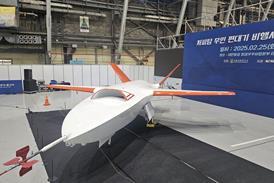BOEING IS NOW formally offering the stretched 767-400ERX to airlines. Authority to offer was given at the beginning of January, and the company expects a formal launch early this year, leading to a first flight in 1999 and certification and first delivery in 2000 (Flight International, 18-31 December, 1996, P5).
Programme manager John Quinlivan says that the 767-400ERX is being offered in response to airline interest in an aircraft with the same range as the current 767-300ER, but with increased capacity. Boeing has been studying 767 derivatives for several years, but Quinlivan says that the -400ERX has emerged "-because of customer requests for an aircraft with more passengers, able to fly the same route structures [as the -300ER]."
The insertion of two plugs will stretch the fuselage by a total of 6.4m and increase two-class seating capacity to 303, from 269 for the -300ER. Maximum take-off weight will be increased to 200,000kg, from 187,000kg for the -300ER. Wing aerodynamic improvements, including wingtip extensions and canted winglets which increase span by 7m, will offset the weight increase and enable the -400ERX to be flown on the same routes as the -300ER, without additional fuel and using the same 276kN (62,000lb)-thrust General Electric, Pratt & Whitney or Rolls-Royce engines.
Quinlivan says that other design changes will include:
- an additional wing leading-edge slat section outboard;
- a longer landing gear, using 777 wheels and brakes;
- increased electrical power-generation, from 90kVA to 120kVA, to accommodate inflight-entertainment demands;
- a new auxiliary-power unit.
The 767-400ERX is designed to replace the Lockheed L-1011 TriStar and McDonnell Douglas DC-10, as well as older Airbus A300s and A310s. The aircraft is a direct competitor for Airbus' "shrunk" A330-200, but offers better operating costs than the heavier Airbus aircraft, with a 5% lower fuel consumption, Quinlivan claims. "We will carry the same number of passengers [as the A330-200], and do so more economically," he says.
Interested airlines are seeking a "seamless transition" from the 767-300, Quinlivan says, adding that "one significant order" will be enough to launch the programme. Boeing is pursuing a launch order for more than 40 767-400ERXs from Delta Air Lines, which already operates the -300ER.
Current plans call for the -400ERX to have an interior based on that of the -300ER - not the 777, as earlier believed. Quinlivan says that the 777 interior has flexibility features which add to cost and weight and may not be required by -400ERX customers. The basic -300ER two-pack air-conditioning system will be modified to cope with the -400ERX's larger passenger cabin, he says.
Quinlivan will not be drawn on a purchase price for the -400ERX, except to say that it will be more expensive than the -300ER, which is priced at $97-107 million. Boeing plans to continue building the 767-300ER alongside the -400ERX, but "-the market will decide" whether the existing aircraft remains in production, he says. Combining the new wing with the -300ER fuselage is also under study, Quinlivan confirms.
While Quinlivan anticipates that "-some work will be done at McDonnell Douglas", the new -400ERX will be assembled on the existing 767 line at Boeing. Existing airframe subcontractors will supply sections of the aircraft, although Boeing has yet to decide where the wingtip extensions and winglets will be built.
Source: Flight International























